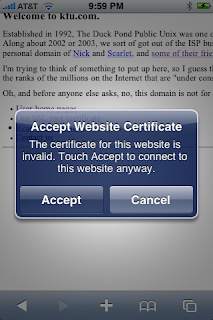EchoLink is an interesting new system that allows amateur radio operators to access radio systems (and in particular, repeaters) over the Internet. It's a lot like
The Internet Repeater Linking Project, except that EchoLink is not limited to repeater station membership. On EchoLink, individual hams can be nodes and connect with repeaters around the world. The only requirement is to prove to the system managers that you are a licensed amateur radio operator. Fortunately, at least for US hams, proof of holding a
Logbook Of The World signing key is sufficient. If you don't have one of those, then
other means can be used to validate your license.
So far, so good. EchoLink software is available for Windows, but additionally, a program called
EchoMac has been made available for MacOS X users to use.
EchoMac inspired me to perhaps give a thought to writing an EchoLink client iPhone app. Since EchoMac is open source, I should be able to use it to figure out the protocol. But I shouldn't have to resort to that. It's probably easier to simply implement the protocol from its documentation - something I've done a few times before.
There's no mention on the EchoLink site of any protocol documentation. Now, since your connection to the EchoLink servers requires callsign/password authentication, there's no particular
Security by Obscurity going on here. That means that there should be no problem with sharing the protocol spec.
So I sent an inquiry in to the EchoLink folks. Here's their reply:
Thanks for writing.
There isn't any good developer documentation available, since the EchoLink system itself was not envisioned as a developer's platform, and we don't encourage development of clients for other platforms.
Really? These are Amateur Radio operators telling folks that they don't encourage development of alternative client software. Do they have any grasp of the history of amateur radio? Have they actually read
§97.1(c)?
I still think I'm going to give it a try, since I'm still waiting for sufficient budget to return to the DATV arena and want something to do in the meantime, but I just thought it unbelievably astonishing that that kind of attitude could exist within this hobby.



